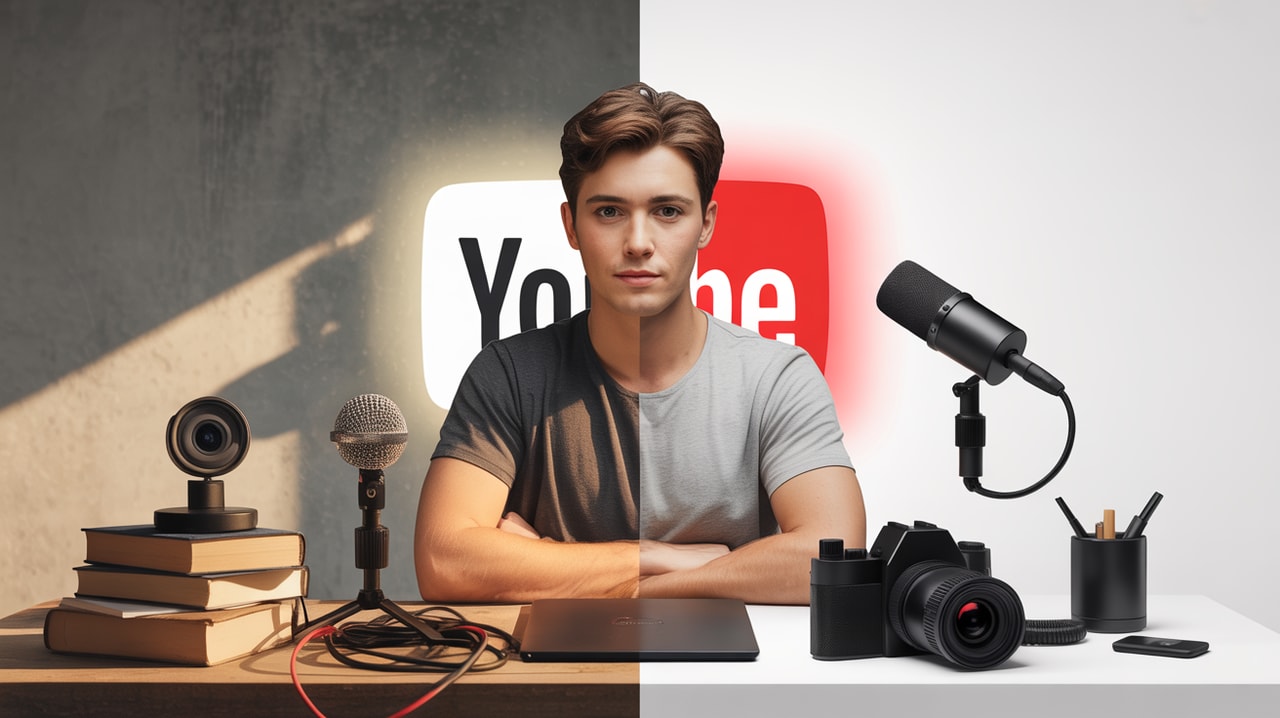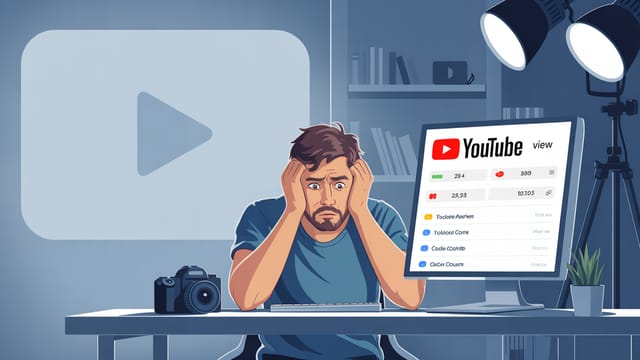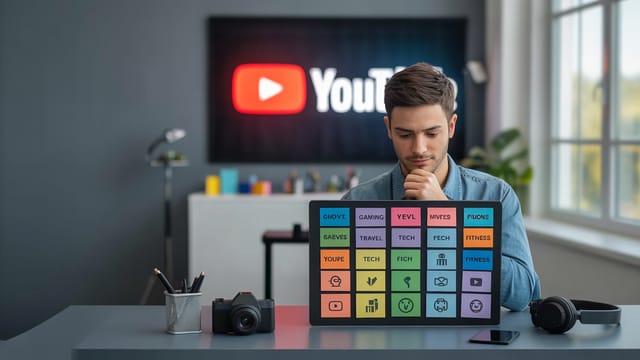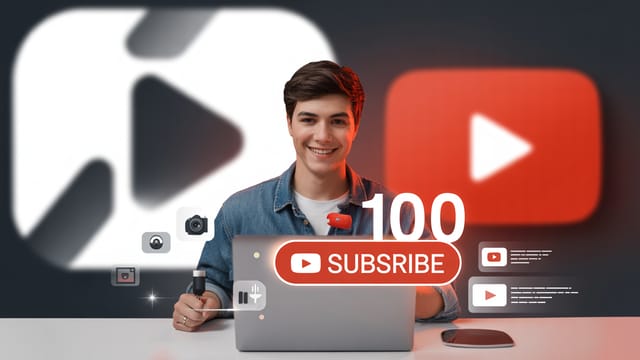
Ready to get your next 10,000 subscribers?
Join thousands of creators who use Subscribr to create faster, better YouTube videos.
Starting a YouTube channel on a tight budget is a reality for most creators. The temptation to save money by buying the cheapest equipment is strong. After all, isn't it better to just start somewhere? While getting started with what you have is crucial advice – and often means using your smartphone – there comes a point where "good enough" gear stops being a money-saver and starts costing you in hidden ways.
Many budget-conscious creators grapple with the perceived high cost of entry or upgrading equipment. There's also the fear of investing in expensive gear only for it to become obsolete or make the wrong purchase decision. This leads to a cycle of buying cheap fixes that ultimately hinder growth and cost more in the long run.
This article will dive into the often-overlooked costs of using subpar equipment, exploring how skimping on essential tools can actually waste your time, compromise your quality, and force you into repeated, costly replacements.
The Allure of Afordable Gear (and the Trap)
When you're just starting or looking to make a small upgrade, the price difference between the cheapest option and a slightly better, mid-range piece of equipment can seem significant. A $30 microphone looks much more appealing than a $150 one when your budget is stretched thin. This is understandable; you want to minimize risk and keep costs low while you test the waters.
However, this focus solely on the upfront price tag ignores a critical concept: the long-term return on investment (ROI) of your gear. As insights from YouTube strategists often emphasize, the most important investment you can make, especially early on, is in your knowledge of content strategy, audience retention, and crafting compelling videos. But once you have the strategic know-how, your gear becomes the tool that enables you to execute that strategy effectively.
Cheaper gear promises functionality, but often delivers frustration. It's the tripod that wobbles, the microphone that picks up every background noise, the light that flickers or casts harsh shadows, or the editing computer that crashes constantly. These aren't just minor annoyances; they are significant roadblocks that directly impact your ability to create quality content efficiently.
The Hidden Costs: Time, Quality, and Reliability
The true cost of cheap gear isn't just the purchase price; it's the ongoing toll it takes on your time, the limitations it places on your content quality, and its inherent lack of reliability.
The Cost of Wasted Time
Time is arguably a creator's most valuable resource. Every minute spent troubleshooting faulty equipment is a minute not spent planning, filming, editing, or promoting your videos.
- Setup Headaches: Cheap tripods might be flimsy and hard to adjust, taking extra time to get a stable shot. Affordable lighting might require awkward positioning or diffusion hacks that eat into your precious filming window.
- Troubleshooting Issues: A low-quality microphone might suddenly cut out, force you to re-record entire sections, or require extensive post-production noise reduction that is time-consuming and often imperfect. An underpowered computer can make editing a painfully slow process, with frequent crashes leading to lost work and frustration.
- Workaround Inefficiency: You might spend hours trying to compensate for poor equipment performance through complex editing techniques or awkward filming setups. This takes away from focusing on the creative aspects of your content.
As YouTube strategist advice highlights, one of the key questions to ask before buying gear is: "Will this help me save time?" If cheap gear constantly costs you time in setup, troubleshooting, and workarounds, its initial price saving is quickly negated.
The Cost to Content Quality and Viewer Retention
While content value trumps production value, there's a baseline of technical quality viewers expect. Poor audio, shaky video, or distracting lighting can make even the most brilliant content hard to watch.
- Poor Audio: Viewers are often more tolerant of imperfect video than bad audio. A cheap microphone might sound tinny, muffled, or plagued by static, making your message unclear and forcing viewers to click away.
- Subpar Visuals: Shaky footage from a weak tripod or poorly lit scenes can look unprofessional and distract from your content. While cinematic quality isn't necessary for many niches, basic stability and adequate lighting are crucial for viewer comfort.
- Inconsistent Results: Cheap gear often provides inconsistent performance. One day the audio is passable, the next it's unusable. This unpredictability makes maintaining a consistent quality standard across your videos incredibly difficult.
In a crowded platform, viewer retention is paramount. If your technical quality frustrates viewers, they won't stick around, no matter how good your information is. This directly impacts your watch time, which is a key signal to the YouTube algorithm.
The Cost of Unreliability and Eventual Replacement
Cheap gear is often built with lower-quality components and less stringent manufacturing standards. This means it's more prone to breaking or failing prematurely.
- Frequent Breakage: That flimsy tripod leg snaps, the microphone cable frays, the light stand collapses. Now you're not just inconvenienced; you're forced to buy a replacement, potentially right in the middle of needing to film.
- Rapid Obsolescence (Due to Failure, Not Technology): While technology evolves, cheap gear often fails before it's technically obsolete simply because it wasn't built to last. You end up replacing it sooner than a more durable, mid-range alternative.
- Cumulative Cost: Buying three cheap microphones over two years because they keep breaking is more expensive than buying one reliable mid-range microphone that lasts for five years. The initial saving evaporates with every replacement purchase.
This cycle of buying, breaking, and replacing is a significant long-term cost of budget gear that is rarely factored into the initial purchase decision.
Framing Gear Investment as ROI
Instead of viewing equipment purchases solely as expenses, think of them as investments in your content and your channel's potential. Ask yourself the strategic questions recommended by experienced creators:
- Will this help me save time? A faster computer, a more reliable microphone, or a sturdy tripod can significantly streamline your workflow, freeing up time to focus on content creation and strategy. Time saved is money earned (or at least, potential earnings realized).
- Will this help me make more money (directly or indirectly)? Will the improved quality allow you to attract more viewers, increase watch time (leading to higher ad revenue), land better brand deals, or even offer freelance video services? Consider how the gear contributes to your overall brand perception and monetization opportunities.
- Is this a need or a want? This is crucial for avoiding "Gear Acquisition Syndrome" (GAS) – the urge to constantly buy new equipment you don't truly need. Identify the specific limitations your current gear imposes and find a solution that addresses that need, rather than just buying the latest gadget.
For budget-conscious creators, the goal isn't necessarily the most expensive gear, but the gear that provides the best balance of quality, reliability, and time-saving features within your budget. This often points towards durable mid-range options rather than the absolute cheapest available.
Prioritize the Essentials: Audio and Lighting First
When making smart investments, prioritize the gear that has the most significant impact on viewer experience: audio and lighting.
- Audio is King: As mentioned, viewers tolerate poor video more than poor audio. Investing in a decent microphone (like a good USB mic for desktop setups or a lavalier mic for on-camera speaking) should be a top priority after your camera source (often, your smartphone).
- Lighting Transforms Visuals: Good lighting can make even a smartphone camera look significantly better. Simple, affordable lighting setups (like basic softboxes or even utilizing natural window light effectively) can dramatically improve your video quality without needing an expensive camera body.
Experienced creators advise distributing your investment across essential tools rather than putting all your money into just an expensive camera body. A great camera won't save bad audio or poor lighting.
The Debt Trap: Build at the Speed of Cash
A common mistake driven by the desire for better gear is going into debt to acquire it. YouTube strategists strongly advise against this. The pressure of debt can add unnecessary stress, and if your channel doesn't grow as quickly as planned or you decide to pivot, you're left with payments for equipment that isn't serving its purpose.
Start with the gear you already own – your smartphone is a powerful tool capable of capturing high-quality video. As your channel generates revenue (through ad revenue, affiliate marketing, or other monetization strategies), reinvest that cash flow back into upgrading your equipment strategically. This allows you to build your channel sustainably and peacefully, ensuring your gear investments are supported by actual growth.
Smart Budgeting and Selecting Gear for Value
Making smart gear choices on a budget involves research and focusing on value over just price.
- Research: Look for reviews and comparisons of mid-range gear. What do other creators in your niche recommend? Focus on reliability and performance for the price.
- Buy Used (Carefully): Purchasing used equipment can be a way to get higher-quality gear at a lower price. Use reputable platforms and understand the risks involved.
- Rent or Borrow: For specific projects or to test out equipment before buying, consider renting or borrowing gear.
- Focus on Needs, Not Wants: Constantly evaluate if a new piece of gear is truly necessary to improve your content or workflow, or if it's just a desire fueled by GAS.
Remember, the goal is to acquire tools that enable you to create your best possible content consistently and efficiently, without breaking the bank or going into debt.
Tools and Resources for Strategic Content Creation
While gear is important, it's only one piece of the puzzle. Understanding your audience, planning your content strategically, and optimizing your videos are equally, if not more, critical for growth.
Tools like Subscribr are designed to help creators with the strategic side of YouTube. Subscribr's Channel Intelligence system can analyze your performance metrics and velocity scoring to identify exactly what's working on your channel. You can use Subscribr's Competitive Analysis tools to study top performers in your niche and identify content gaps, informing what types of videos you should be making.
When you're ready to script, Subscribr's AI Script Writer and Smart YouTube Script Writer can help you go from blank page to viral script, trained specifically on successful YouTube content. Subscribr's Research Assistant provides high-quality research, including analyzing YouTube transcripts and web pages, helping you gather information efficiently before you even start writing. By using tools that streamline your workflow and provide data-driven insights, you can focus your energy on creating high-value content, making your gear investments even more impactful.
Conclusion
The initial price of cheap YouTube equipment can be deceptive. While it offers a low barrier to entry, the hidden costs in wasted time, compromised quality, unreliability, and the eventual need for replacement can quickly add up, costing you more in the long run than a slightly larger initial investment in better gear.
Instead of falling into the "good enough" trap, approach gear purchases strategically. Ask how a piece of equipment will save you time or help you make more money. Prioritize essential upgrades like audio and lighting. Avoid going into debt and instead, build your gear collection gradually using the cash flow generated by your channel's growth.
By making smart, informed decisions about your equipment, you're not just buying cameras and microphones; you're investing in the efficiency, quality, and long-term potential of your YouTube channel. This strategic approach ensures your gear empowers your content, rather than hindering it.





